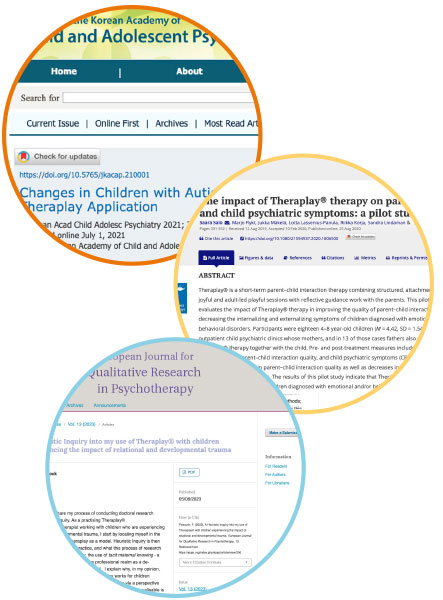Forskning
Theraplay-metoden er opstået i en praksisverden, hvilket er med til at forklare, hvorfor Theraplay®-Instituttet ikke har været forbundet med forskermiljøet på universiteterne. Igennem tiden har man i stedet for valgt at udbrede kendskabet til Theraplay, MIM og Sunshine Circles gennem undervisning. I dag er der naturligvis et stærkt ønske om en større evidensbaseret praksis.
Nedenfor finder du en oversigt over de publikationer, der er optaget i peer reviewed tidsskrifter og anden relevant forskning. Der er både publikationer, der omhandler Theraplay, MIM og Sunshine Circles. Vi ajourfører løbende.
- Bennett, L.R., Shiner, S.K. and Ryan, S. (2006). “Using Theraplay in Shelter Settings with Mothers and Children Who Have Experienced Violence in the Home”, Journal of Psychosocial Nursing and Mental Health Service, 44 (10), 38-47.
- Bojanowski, J. J., & Ammen, S. (2011). Discriminating Between Pre- Versus Post-Theraplay Treatment Marschak Interaction Methods using the Marschak Interaction Method Rating System. International Journal of Play Therapy, 20(1), 1–11. https://doi.org/10.1037/a0022668
- Chang, Y., Kim, B., & Youn, M. (2021). Changes in Children with Autism Spectrum Disorder after Theraplay Application. Journal of the Korean Academy of Child and Adolescent Psychiatry, 32(3), 112–117. https://doi.org/10.5765/jkacap.210001
- Cort, L. & Rowley, E. (2015). A case study evaluation of a Group Theraplay intervention to support mothers and their preschool children following domestic abuse (Research in Brief). British Psychological Society, Debate 156.
- Eruyar, S., & Vostanis, P. (2020). Feasibility of group theraplay with refugee children in Turkey. Counselling and Psychotherapy Research, 20(4), 626–637. https://doi.org/10.1002/capr.12354
- Francis, Y. J., Bennion, K., & Humrich, S. (2017). Evaluating the outcomes of a school based Theraplay® project for looked after children. Educational Psychology in Practice, 33(3), 308–322. APA PsycInfo. https://doi.org/10.1080/02667363.2017.1324405
- Friend, J. (2012). Mitigating Intergenerational Trauma Within the Parent-Child Attachment. Australian and New Zealand Journal of Family Therapy, 33(02), 114–127. https://doi.org/10.1017/aft.2012.14
- Fuller, W. (1995). Theraplay as a treatment for autism in a school-based day treatment setting. Continuum: The Journal of the American Association for Partial Hospitalization 2, 2, 89-93.
- Hiles Howard, A. R., Lindaman, S., Copeland, R., & Cross, D. R. (2018). Theraplay impact on parents and children with autism spectrum disorder: Improvements in affect, joint attention, and social cooperation. International Journal of Play Therapy, 27(1), 56–68. APA PsycInfo. https://doi.org/10.1037/pla0000056
- Hitchcock, D. L., Ammen S., O’Connor, K., Backman, T. L. (2008). Validating the Marschak Interaction Method Rating System with Adolescent Mother-Child Dyads. International Journal of Play Therapy, Vol 17(1), 24-38.
- Jernberg, A. M. (1984). Theraplay: Child Therapy for Attachment Fostering. Psychotherapy, 21(Spring), 39–47.
- Kim, Y.-K., & Nahm, S. (2008). Cultural considerations in adapting and implementing play therapy. International Journal of Play Therapy, 17(1), 66–77. https://doi.org/10.1037/1555-6824.17.1.66
- Makela, J. (2005). The Importance of Touch in the Development of Children. Finnish Medical Journal, 60,1543–9. Published research in peer-reviewed journals: Case or Program Descriptions
- Makela, J. & Salo, S. (2011) Theraplay –vanhemman ja lapsen välinen vuorovaikutushoito lasten mielenterveysongelmissa. (Theraplay- Parent-child interaction treatment for children with mental health problems) Duodecim 127, 29-39.
- Makela, J. & Vierikko, I. (2005) From heart to heart: Interactive therapy for children in care. Report on the Theraplay project in SOS Children’s Villages in Finland 2001-2004. The SOS Children’s Villages Association, Finland.
- Martin, E. E., Snow, M. S., Sullivan, K. (2006). Patterns of relating between mothers and preschool-aged children using Marschak Interacion Method Rating System. Early Child Development and Care, Vol 178(3), 305-314.
- Money, R., Wilde, S., & Dawson, D. (2020). Review: The effectiveness of Theraplay for children under 12 – a systematic literature review. Child and Adolescent Mental Health, camh.12416. https://doi.org/10.1111/camh.12416
- Peacock, F. (2023). A Heuristic Inquiry into my use of Theraplay® with children experiencing the impact of relational and developmental trauma. European Journal for Qualitative Research in Psychotherapy, 13. Retrieved from https://ejqrp.org/index.php/ejqrp/article/view/200
- Purrington, J., Goodall, S., & Lynch, J. (2023). Family-based psychological interventions for domestically adoptive families: A systematic review. European Child & Adolescent Psychiatry. https://doi.org/10.1007/s00787-023-02210-y
- Purrington, J., Hartley, G. & Lyne, N. (2023). Service Uers’ Experienes of a 6-Week Remotely Delivered Theraplay-Informed Group Intervention for Carers: A Qualitative Service Evaluation. International Journal of Play Therapy, Vol. 32, No. 3, 181-195. https://doi.org/10.1037/pla0000201
- Robison, M., Lindaman, S. L., Clemmons, M. P., Doyle-Buckwalter, K., & Ryan, M. (2009). “I Deserve a Family”: The Evolution of an Adolescent’s Behavior and Beliefs About Himself and Others When Treated with Theraplay in Residential Care. Child and Adolescent Social Work Journal, 26(4), 291–306. https://doi.org/10.1007/s10560-009-0177-x
- Salisbury, S. (2018). Using attachment enhancing activities based on the principles of Theraplay® to improve adult-child relationships and reduce a child’s ‘overall stress’ as measured by the Strength and Difficulties Questionnaire (SDQ). Emotional and Behavioural Difficulties, 23(4), 424–440. https://doi.org/10.1080/13632752.2018.1497000
- Salo, S., Flykt, M., Mäkäla, J., Biringen, Z., Kalland, M., Pajulo, M. & Punamäki, R. L. (2019). The effectiveness of Nurture and Play: a mentalisation-based parenting group intervention for prenatally depressed mothers. Primary Health Care Research & Development 20(e157): 1-11. https://doi.org/10.1017/S1463423619000914
- Salo, S., Flykt, M., Mäkelä, J., Lassenius-Panula, L., Korja, R., Lindaman, S., & Punamäki, R.-L. (2020). The impact of Theraplay® therapy on parent-child interaction and child psychiatric symptoms: A pilot study. International Journal of Play, 9(3), 331–352. https://doi.org/10.1080/21594937.2020.1806500
- Salo, S., Lampi, L. & Lindaman, S. (2010) Use of the emotional availability scales to evaluate attachment-based intervention Theraplay- in substance abusing mother-infant dyads in Finland. Infant mental health Journal Supplement 2010: 32:77.
- Simeone-Russell, R. (2011). A practical approach to implementing theraplay for children with autism spectrum disorder. International Journal of Play Therapy, 20(4), 224–235. https://doi.org/10.1037/a0024823
- Siu, A. F. Y. (2009). Theraplay in the Chinese world: An intervention program for Hong Kong children with internalizing problems. International Journal of Play Therapy, 18(1), 1–12. https://doi.org/10.1037/a0013979
- Siu, A. F. Y. (2014). Effectiveness of Group Theraplay® on enhancing social skills among children with developmental disabilities. International Journal of Play Therapy, 23(4), 187–203. https://doi.org/10.1037/a0038158
- Siu, A. F. Y. (2021). Does age make a difference when incorporating music as a rhythmic-mediated component in a theraplay-based program to facilitate attunement of preschool children with social impairment? International Journal of Play Therapy, 30(2), 136–145. https://doi.org/10.1037/pla0000131
- Siu, A. F. Y. (2023). Evaluating two play-based approaches for children and carers in residential settings: A mixed-method, randomized control study. International Journal of Play Therapy, 32(2), 63-74. https://doi.org/10.1037/pla0000130
- Smithee, L. C., Krizova, K., Guest, J. D., & Case Pease, J. (2021). Theraplay as a family treatment for mother anxiety and child anxiety. International Journal of Play Therapy, 30(3), 206–218. https://doi.org/10.1037/pla0000153
- Tucker, C., Schieffer, K., Lenz, S., & Smith, S. (2021). Sunshine Circles: Randomized Controlled Trial of an Attachment-Based Play Group with Preschool Students Who are At-Risk. Journal of Child and Adolescent Counseling, 1–15. https://doi.org/10.1080/23727810.2021.1940658
- Tucker, C., Schieffer, K., Wills, T. J., Hull, C., & Murphy, Q. (2017). Enhancing social-emotional skills in at-risk preschool students through Theraplay based groups: The Sunshine Circle Model. International Journal of Play Therapy, 26(4), 185–195. APA PsycInfo. https://doi.org/10.1037/pla0000054
- Tucker, C. & Smith, S. (2018). Using play to enhance growth in children who have experienced trauma: Theraplay groups as early intervention. Young Exceptional Children Monograph Series, 17, 72-81.
- Weaver, J. L., Medyk, N. V., Swank, J. M., Daniels, P. F., & Smith-Adcock, S. (2021). A phenomenological study of Theraplay groups within a middle school. International Journal of Play Therapy, 30(2), 125–135. https://doi.org/10.1037/pla0000139
- Weir, K. N. (2008). Using Integrative Play Therapy with Adoptive Families to Treat Reactive Attachment Disorder: A Case Example. Journal of Family Psychotherapy, 18(4), 1–16. https://doi.org/10.1300/J085v18n04_01
- Weir, K. N., Lee, S., Canosa, P., Rodrigues, N., McWilliams, M., & Parker, L. (2013). Whole Family Theraplay: Integrating Family Systems Theory and Theraplay to Treat Adoptive Families. Adoption Quarterly, 16(3–4), 175–200. https://doi.org/10.1080/10926755.2013.844216
- Wettig, H. H. G., Coleman, A. R., & Geider, F. J. (2011). Evaluating the effectiveness of Theraplay in treating shy, socially withdrawn children. International Journal of Play Therapy, 20(1), 26–37. https://doi.org/10.1037/a0022666
- Yazdanipour, M., Ashori, M., & Abedi, A. (2022). Impact of group theraplay on the social–emotional assets and resilience in children with hearing loss. International Journal of Play Therapy, 31(2), 107–118. https://doi.org/10.1037/pla0000175

